Lanzhou beef noodle soup features springy noodles, melt-in-your-mouth beef, a bit of homemade fresh chili oil, and a rich broth. It’s a simple dish but you can’t help but wonder about the magical power of a plain bowl of beef noodles.
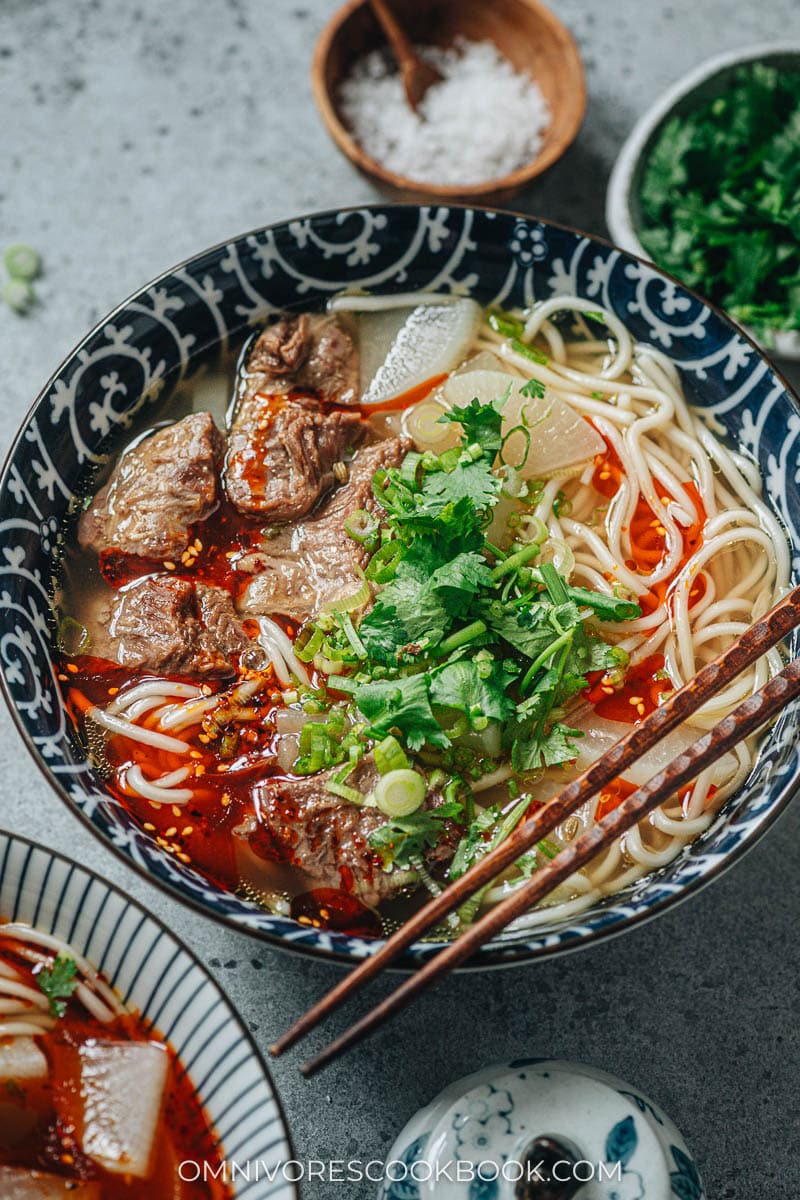
What is Lanzhou beef noodle soup
Lanzhou beef noodle soup, or Lanzhou La Mian (兰州拉面), is a popular Chinese noodle dish that originated in Lanzhou, the capital city of Gansu province in northwestern China.
Lanzhou beef noodle soup is famous for its simplicity, yet it takes some effort to get right.
One of the defining features of Lanzhou beef noodle soup is the hand-pulled noodles. They are usually made fresh by the chef, skillfully stretching and folding the dough to create long, thin, and even strands. The noodles are served in a clear, savory beef broth. The broth contains beef, beef bones with various spices and seasonings, simmered for hours to create a broth that’s so savory and hearty. The noodles are topped with tender beef pieces, radishes, cilantro, and a dash of chili oil.
In China, the real-deal Lanzhou beef noodle recipe is a commercial secret. Every noodle restaurant guards their own recipe as a secret weapon and it’s quite difficult to replicate it at home.
The good news is, I’ve found that if you get the ingredients right, it’s possible to create a very similar dish in your own kitchen.
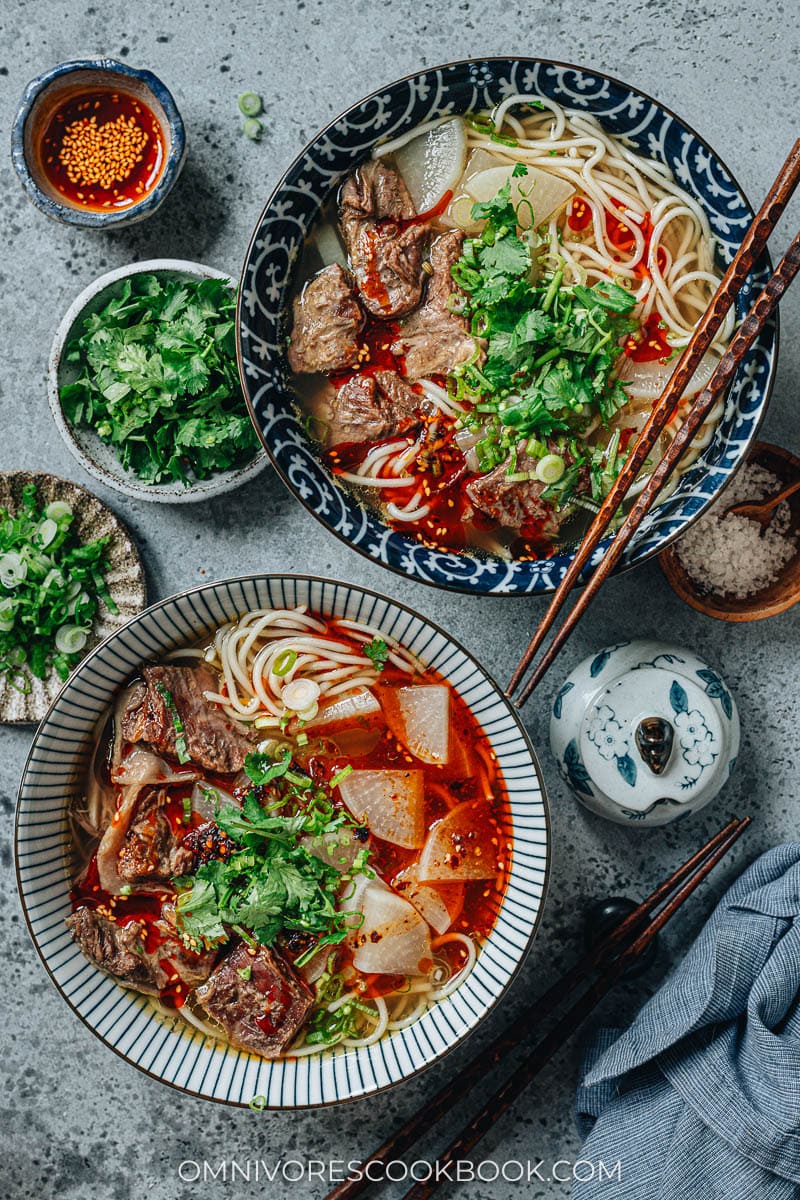
Lanzhou beef noodle soup ingredients
What type of noodle to use
If you want an authentic experience, the best answer is to make your hand-pulled noodles. I do have a hand-pulled noodle recipe here. It definitely takes some time and effort, but it’s not a super difficult thing to do if you follow my method.
However, if you have access to an Asian market, I highly recommend the Lanzhou Fresh Noodles by Havista. They are semi-dried noodles that have a nice, chewy texture once boiled. I really like them a lot for this.
If you do not have access to these noodles, you can also use dried noodles made with wheat. And the shape should be similar to spaghetti noodles.
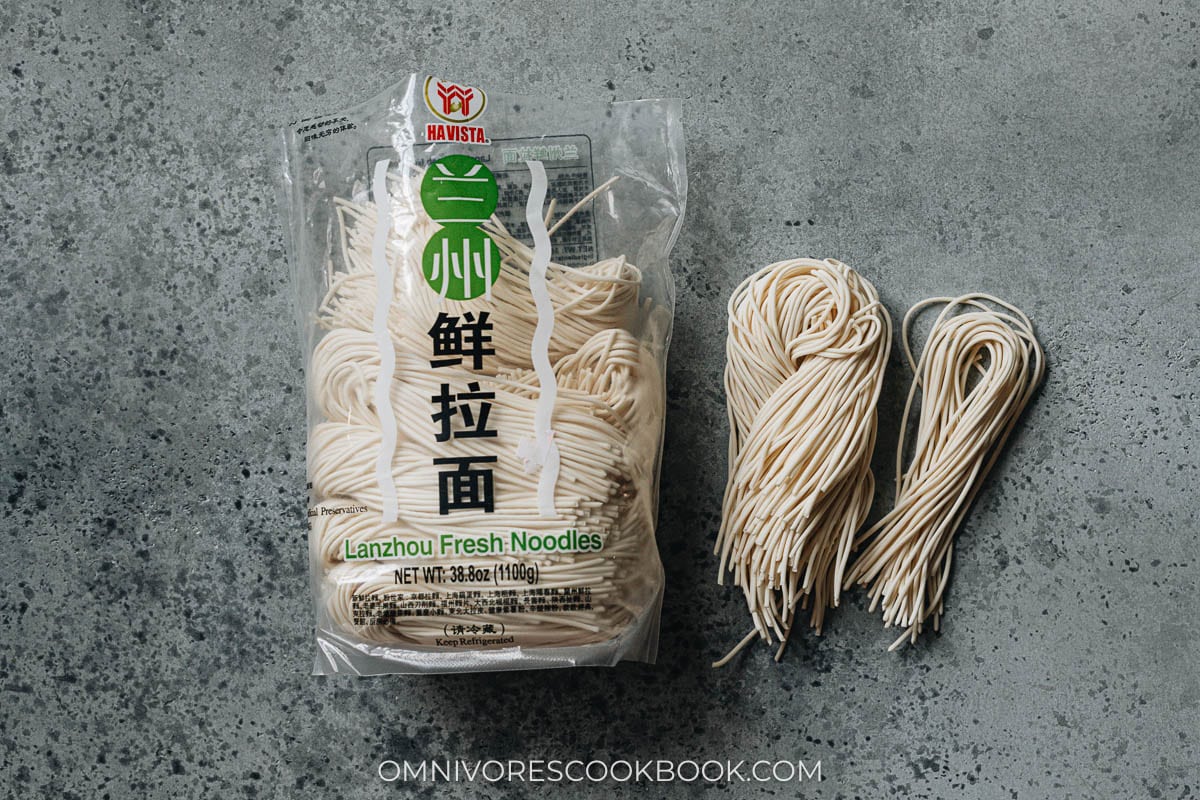
Beef and bones for the broth
You will need beef and beef bones to make a super rich broth.
For the beef, the best option is untrimmed flank steak. It is called Niu Nan (牛腩) in Chinese. Since the cut of the beef is quite different from the ones in the regular grocery stores in the US, you will most likely find it in a Chinese market. The cut is quite fatty with its untrimmed membranes. The fat and the membranes melt away during the cooking, keeping the beef buttery tender and juicy.
Alternatively, you can also use cuts such as brisket, round roast, or chuck.
I like to use beef shin bones for my Lanzhou beef noodle soup, but you can also use neck bones instead.
Mise en place
When you’re ready to cook, you should have:
- Beef shin bone pieces
- Sliced beef pieces
- Daikon radish
- Aromatics (ginger, garlic, scallion)
- Spices (chili pepper, bay leaves, fennel seeds, nutmeg, cinnamon stick, star anise, whole cloves, and Sichuan peppercorns)
- Salt
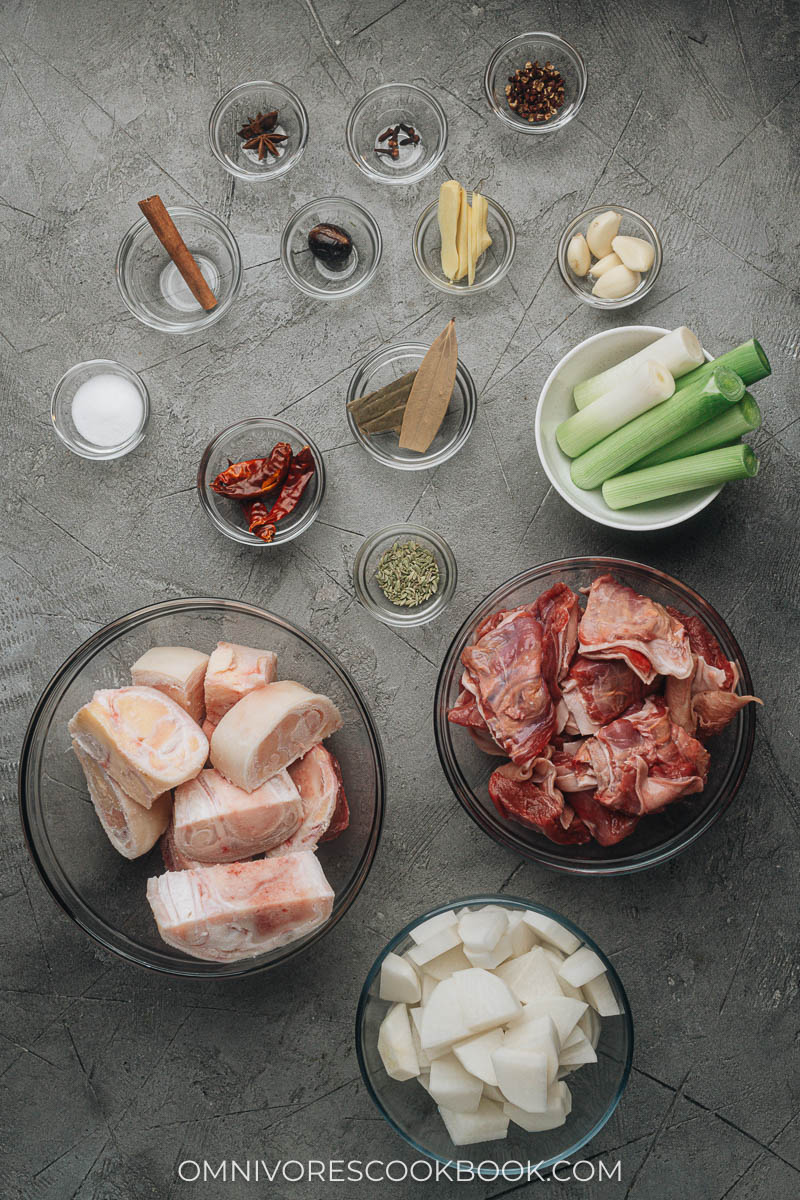
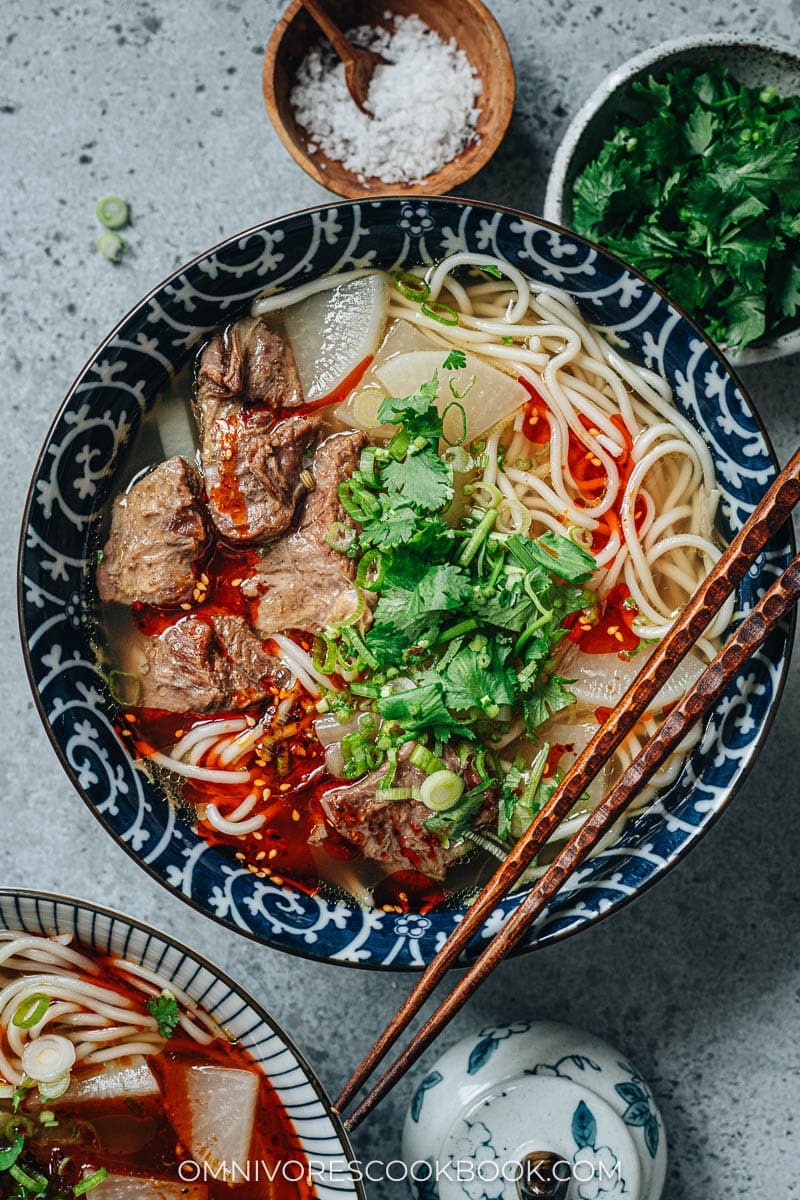
How to make Lanzhou beef noodle soup
Making Lanzhou beef noodle soup is quite easy with an Instant Pot or a pressure cooker:
- Blanch the beef and the bones
- Skim the foam from the top and discard it (to keep the broth clear)
- Transfer the beef, bones and broth into an Instant Pot, then add the spices and aromatics
- Cook at high pressure until the beef is tender and the broth is rich
- Transfer the beef pieces onto a plate. Discard the bones and the spices.
- Cook the radishes in the broth until tender
- Boil the noodles
- Assemble the beef noodle soup
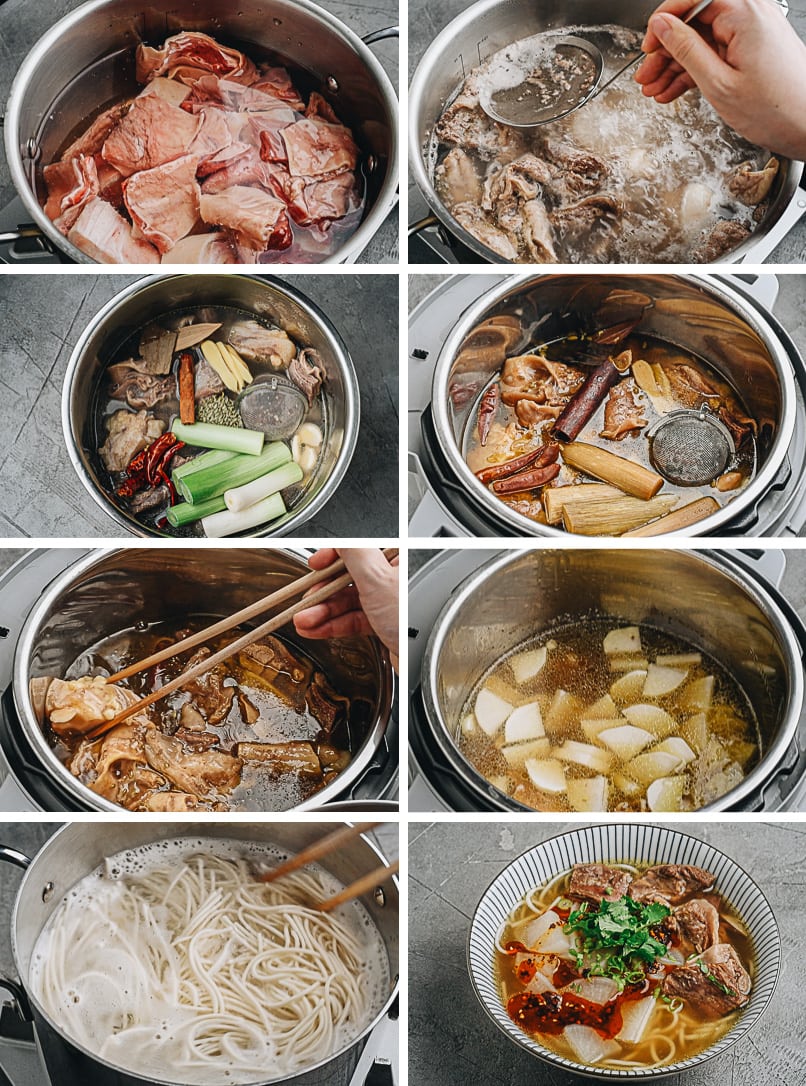
Cook without an Instant Pot
If you don’t have an Instant Pot, no worries! The cooking is actually very straightforward.
Instead of moving everything into the Instant Pot, you can keep braising everything together after the initial blanching. The only downside is that the broth will take hours to simmer to reach the desired flavor.
How to serve Lanzhou beef noodle soup
Lanzhou beef noodle soup is usually served by itself as a quick main dish in a restaurant. It’s commonly accompanied by simple appetizers such as cucumber salad, wood ear mushroom salad, and braised peanuts.
However, if you’re planning to host a dinner party and serve this special dish for it, you can also add a few more small dishes to make a beautiful spread. For example, serve small plates of crispy potstickers, fragrant scallion pancakes, or crunchy egg rolls as an appetizer. Or serve simple vegetables such as zucchini stir fry, garlic green beans, or baby bok choy stir fry on the side.

More delicious noodle recipes
- Cumin Lamb Noodles
- Biang Biang Noodles (Chinese Hot Sauce Noodles)
- Yaka Mein (Beef Noodle Soup)
- Hot Dry Noodles (热干面)
- Green Bean Noodles (豆角焖面)
- Zha Jiang Mian (Old Beijing Fried Sauce Noodle, 炸酱面)
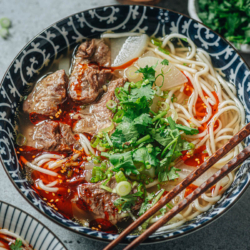
Lanzhou Beef Noodle Soup (兰州拉面)
Ingredients
- 2 to 3 lb (1.4 to 1.8 kg) beef shin bones (*see footnote 1)
- 2 lb (1 kg) untrimmed beef flank , or brisket, or round roast (*see footnote 2), cut into 3” (7 cm) pieces
- 2 Chinese scallions or 4 green onions, white part, cut to 4” (10 cm) pieces
- 1 thumb ginger , sliced
- 5 cloves garlic
- 5 Chinese dried chili peppers
- 5 whole cloves
- 2 bay leaves
- 1 teaspoon whole Sichuan peppercorn
- 1 teaspoon fennel seed
- 1 whole nutmeg
- 1 star anise
- 1 cinnamon stick
- 2 teaspoons salt (or to taste)
- 1 small daikon radish , peeled and sliced to 1/2” (5 mm) quarters
- 1.3 to 2 lbs (600 to 900 g) fresh Lanzhou noodles (or 1 to 1.3 lb / 400 to 600 g dried wheat noodles)
Serving
- Homemade Chinese chili oil (for serving)
- Soy sauce (for serving)
- cilantro , chopped (for garnish)
- green onion , sliced (for garnish)
Instructions
To cook the broth
- Add the beef bones and meat into a large pot. Add 8 cups of cold water. Heat over medium-high heat until brought to a boil. Stir occasionally to prevent the bottom from sticking. When it starts to boil, turn to medium heat. Skim the brown foam from the top and discard it. Boil and skim until the broth turns almost clear, 10 minutes or so.
- Transfer the meat and bones into the Instant Pot, and pour in all the broth. You can keep cooking on the stovetop if not using an Instant Pot. (*Footnote 3)
- (Optional) Add the cloves, Sichuan peppercorn and star anise into a tea infuser. Submerge the tea infuser in the broth.
- Add the scallion, ginger, garlic, dried chili pepper, bay leaves, fennel seed, nutmeg, cinnamon stick into the Instant Pot. Set the pressure on high, timer for 1 hour. Once done, let pressure release naturally. If you want to use fast release, do a natural release for at least 20 minutes first, to prevent it from spilling.
- Once done, remove and discard the spices, aromatics, and beef bones using a pair of tongs. You can also strain the broth if that is easier. But you need to pick out the meat separately.
- You might find a thick layer of oil floating on top of the soup (depending on the fattiness of the beef). Use a ladle to skim the oil off according to your preference (*footnote 4).
- Add salt and mix well. Taste the broth and adjust seasoning if needed. The broth should taste a bit salty by itself, so it will be perfect after adding the noodles. You can also adjust the seasoning later, after assembling the bowls.
- Turn on the saute function if using Instant Pot. Add the daikon radish and cook until tender, 10 minutes or so.
- Boil the noodles according to package instructions.
To assemble noodles
- Add noodles to each serving bowl, then pour in the broth. Top noodles with beef, a few pieces of daikon radish, and some cilantro. Serve immediately with chili oil and soy sauce on the side. Enjoy hot as a main dish.
Notes
- If the bones are not cut, ask the butcher to cut the beef bones lengthwise into short pieces when purchasing.
- Using untrimmed cuts will generate a very tender and moist lean part after simmering. You can trim off and discard the fat before serving. Other beef cuts such as brisket, shank, or round roast are also suitable for this recipe.
- Add 2 cups of water into the pot if you keep cooking on the stovetop. Cover and simmer over low heat for 3 hours, or until the beef turns very tender.
- I usually skim off as much oil as I can and save it. Some people like to serve the broth with oil on top, but I found it delicious enough without the oil. You can use the oil for stir-frying later and it will help you create very delicious dishes. To store beef fat, allow the oil to cool in a small bowl at room temperature, then transfer it to an air-tight container. It can be stored in the fridge for up to 2 weeks.













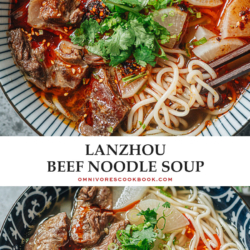
Excellent recipe! I made your recipe this past weekend and it was amazing! Absolutely delicious! Well thought out and easy to follow! I have a question though. Due to time constraints, I’d love to prepare this a day or two before served to guests. I know your instructions say that the broth and the beef can be chilled, or frozen, separately in air tight containers. My question is, what to do with the radish that is placed in the broth 30 minutes prior to finishing the broth? Do I just cook that as well and refrigerate, then just heat it all back up before serving? Thanks again for an amazing dish!
Hi Mark, thanks for taking time to leave a comment and I’m so glad to hear you like the dish! To answer your question, daikon radish holds together rather well so I wouldn’t mind cooking them ahead. What you can do is cook it 15 to 20 minutes prior to finishing the broth, so it won’t turn mushy while reheating. If you want the dish super fresh, you can also reheat the broth in a pot on the stove top and cook the radish right before serving the noodle soup. Hope this is helpful. Let me know if you have further questions 🙂
It might have been OK for me to have tried this recipe first without reading all the details. I might have been intimidated.
I’m attracted to recipes that use star anise or Sichuan peppercorn. So I’ve been wanting to make this for a while. But every time I think about it, I don’t have the ingredients nor the 3~4 hour to cook.
But I finally did it! Although, since I couldn’t remember the recipe correctly I bought lamb instead of beef so to be technical, I didn’t make this 😉 Nevertheless I loved the results. Next time I will try the beef.
Thank you for the recipe!
I lived in Lanzhou for 1 year . Lanzhou beef noodles are AMAZING and I miss it a lot. I have made it here in the States and it took all day but we’ll worth it. The recipe I have is very similar to yours.
Maggie, can beef shortribs be used in place of flank steak
Hi Margaret, yes! Beef short ribs totally work!
Absolutely loved this recipe! It was a big hit in our house last night and will definitely be added to our rotation! Easy to follow, easy to make, easy to love! I also made the chili oil from your recipe and it made all the difference in our noodles!!!
I have a great photo if you’re interested in seeing how it turned out!!!
Hi Marley, I’m glad to hear you like the recipe! Of course, would love to see your photos 🙂
Hi,
In the recipe, you talk about covering the pot, but in your photos (and in other steps) it seems as though lots of water is boiling off.
Can you clarify whether the pot should be covered or left open?
Thanks! I’m cooking it right now so hopefully it goes okay 🙂
Hi Alex, it has been a long time since I posted the recipe, so I’m trying my best to remember it.
I think you should cover the pot. Because the super long cooking time, the broth will reduce too much if you keep the lid open.
You can check on the broth after 3 hours of simmering. If the broth doesn’t taste rich enough, you could always leave the pot uncovered for the last 30 minutes to 1 hour of simmer to reduce it further.
I disagree with the statement that only Lanzhou can make proper Lanzhou beef noodles. I’ve had great beef noodles throughout Gansu province, as well as in Xinjiang, Ningxia, Qinghai, and Shaanxi – You can get great hand-pulled beef noodles throughout the northwest, sometimes even better than those served in Lanzhou.
If you’re talking about places beyond the northwest, Beijing’s are okay but anywhere in the south is disappointing.
This is my regular go to when I need my noodle soup for comfort. For me, I only use the recipe for the broth and just add a store bought dried rice noodles instead. They don’t realize it, but my family are forever in your debt! Thanks so much for your website.
Can I use your Asian beef stock recipe for Lanzhou Beef Noodles recipe?
Yes you can!
Hi Maggie!
Wondering how we can turn this into a instant pot recipe? Maybe brown the beef then pressure cook 45min?
Thanks
Fabulous dish!
Hi, I love your site and have made many of your amazing recipes! I’m curious – why do some of the spices get put in a tea infuser/spice bag while others float freely in the soup, when they all get removed? Do some of them diffuse differently? I’m super excited to try this out! I like adding greens to my soup when I can – bok choy or flat cabbage seem like they might be good in this soup. What do you think? Do you have any other suggestions for greens? Thanks so much!
I used to use my mom’s tea infuser back in China (when I published this recipe) and use it in soup and stews so I can remove the small solid spices easily. I still have the tea infuser but sometimes I just forgot to use it lol Also, many people don’t have it so if a soup really need straining, I usually include that in the steps.
For the greens, bok choy and napa cabbage should work perfectly.
I will have to try this in my Instant Pot. After living in Lanzhou for a year, I loved the soup. I have done it without an IP and it did take a “long minute” to make. Thanks so much for the recipe